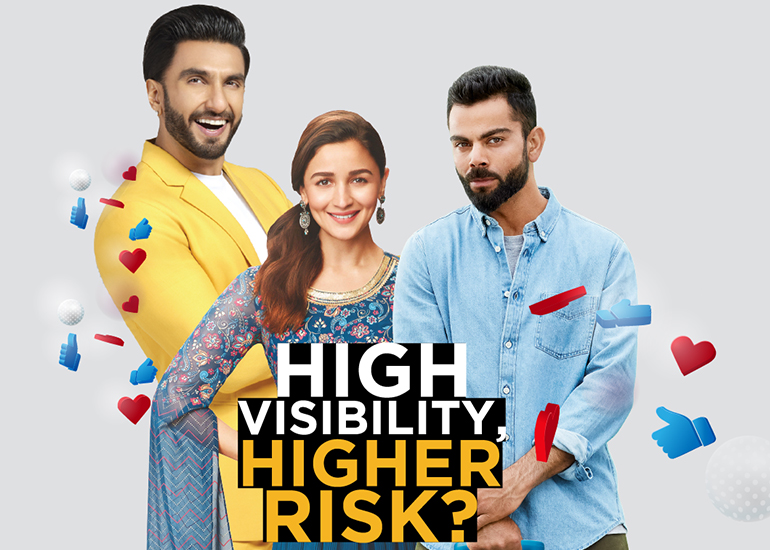Social commerce website Meesho became a subject of social media scrutiny earlier this month following a faux pas by one of its promoters – Sourav Ganguly. The BCCI president was one of the nine celebrities roped in by the brand for its latest campaign – Mega Blockbuster. While the other celebrities such as Deepika Padukone, Rashmika Mandanna and Kapil Sharma acted according to the plan, a copy page error made by Ganguly (and his team) on social media revealed the grand orchestration behind what could have been a great marketing strategy.
Undoubtedly, Meesho found themselves in an uncomfortable position after the error. As a damage control move, they later reacted with a witty post on twitter – ‘When Dada hits, it’s a 6, When Dada mishits, it’s still a 6’.
As expected, officials from the brand later said that the entire episode actually went in their favour. Megha Agarwal, CXO User Growth, Meesho says, “Sourav Ganguly’s tweet created a lot of buzz on social media. Our objective was to create a lot of conversations around this campaign and the outcome is exactly what we wanted it to be.”
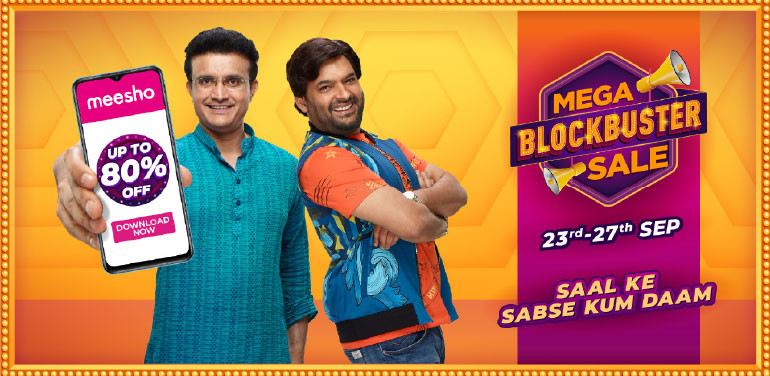
No matter what the brand says, one can’t forget that a lot of marketing dollars invested in the campaign were at stake, when Ganguly’s team committed that blunder. Not always does it have a favourable end for the brand. In this case, Ganguly’s blunder only ruined their original plan, but the fact remains that an error can go so viral and that too so soon, only if it’s made by a celebrity. So, this incident raises a valid question – is it a very high investment and yet a risky proposition to have celebrities on-board for brand endorsement?
The industry insiders differ in their opinions. Ramanuj Shastry- Director and Co- Founder, Infectious Advertising says, “Having celebrities on-board has always been a risky venture. We have to remember that the celebrities are also human beings and they are also prone to errors. If the celebrity does something, which is not in tune with your brand philosophy, then you should be prepared for social media backlash. It is even more risky now, because every customer is a ‘reporter’ and ‘broadcaster’. These days, many brands are embracing Digital out of pure necessity and compulsion, but they should also have proper understanding of it.”
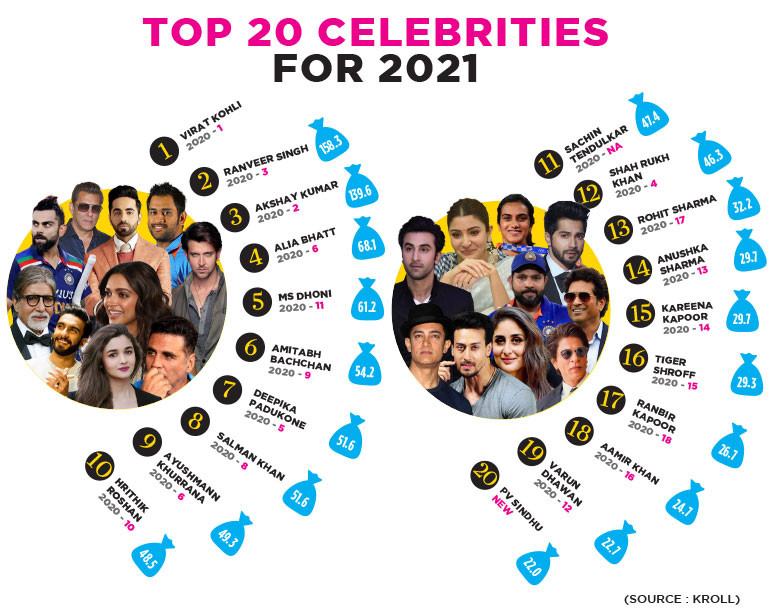
“In marketing initiatives, no matter how much you try, there will always be scopes for communication-gap. So, the entire communication mechanism should be on alert throughout the journey. If something goes wrong, the brand should take quick damage-control measures and if need be, they should also apologize,” he says.
Poulomi Roy, Chief Marketing Officer, RSH Global, on the Meesho episode says, “It was carelessness, on the part of whoever was handling the account for the celebrity. As a society, we have become slightly unforgiving of errors. Some social media users also derive entertainment from failure and negativity. I do not endorse the idea of taking one’s work lightly with a ‘sab chalega’ attitude; the team must be careful. Having said that, one such mistake cannot question the effectiveness of celebrity endorsement for brands. On-boarding a celebrity is not a risky proposition. It is an elaborate task because it entails the amalgamation of celebrity equity and brand equity, and it needs a highly capable team to handle every aspect of such partnerships.”
Mehernosh Pithawalla, Senior Vice President and Head of Brand and Strategic Insights, Godrej & Boyce Mfg. says, “Associating with a celebrity is not a risky proposition as may sometimes be portrayed. In this particular instance, it is commendable that the brand owned the narrative and quickly turned around this human error to make it witty and relatable to their audience. This approach helped them not only garner more attention from their consumers but also their industry peers. Smart associations and owning the narrative should be the takeaway from this incident.”
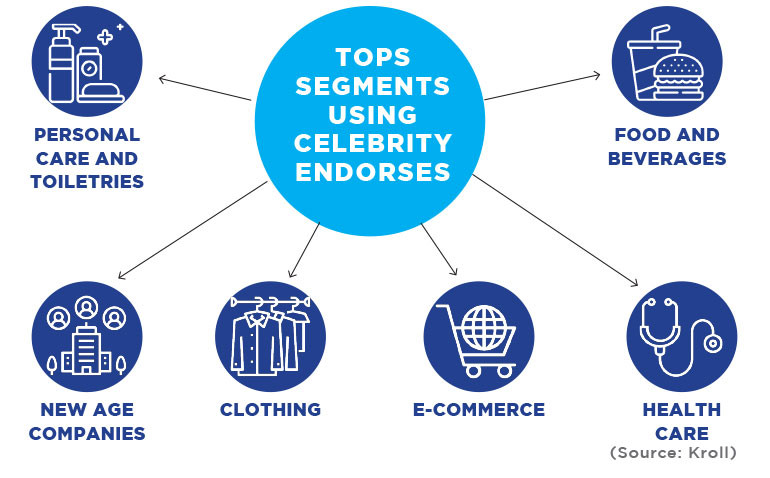
While risk factors involved with the celebrities is a debatable issue, it has been observed that in India, by and large, the brands are prioritising them. Telecom brand, Airtel, recently convinced music maestro A. R. Rahman to do his first ever ad film. Rashmika Mandanna recently joined vegan beauty product brand Plum as a share-holder and brand ambassador, after the actor refused to accept a plain vanilla brand endorsement deal with the brand. The list is long.
According to corporate investigation and risk consulting firm, Kroll’s Celebrity Brand Valuation Report, 2021 (published on March 30, 2022), the number of endorsements of the top 20 celebrities in India increased by more than 50% in 2021.
“Emerging Digital business segments like FinTech, and direct-to-consumer (D2C) witnessed tremendous growth in terms of the number of startups and also in terms of the funds raised during 2021. These well-funded new age companies led to significant growth in the number of endorsements of the top 20 celebrities, increasing by more than 50% from 2020, and constituting about 12% in the overall brand portfolio,” the report says.
As per the report, in terms of brand value, Virat Kohli, Ranveer Singh, Akshay Kumar, Alia Bhatt, and MS Dhoni, were the top five celebrities in 2021.
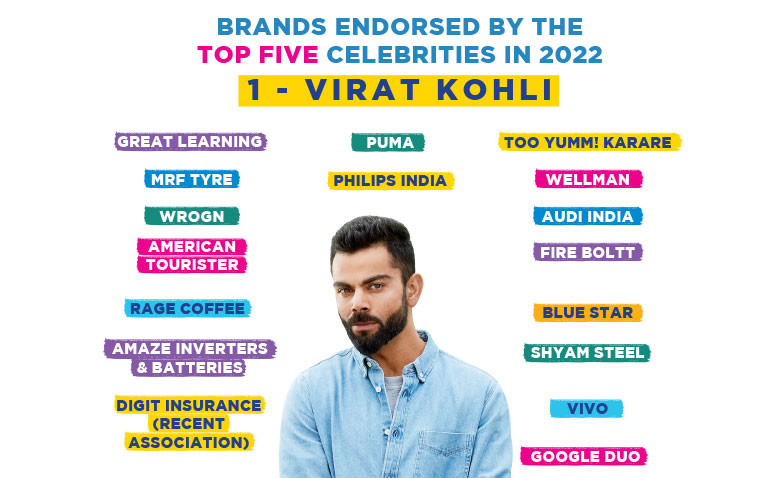
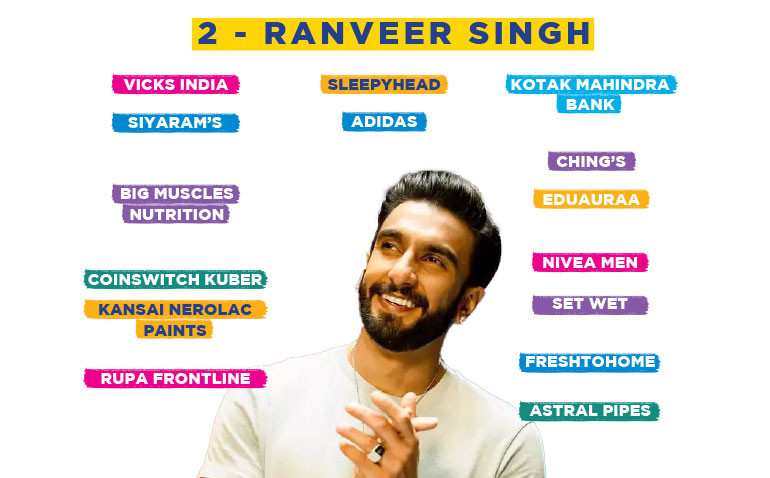

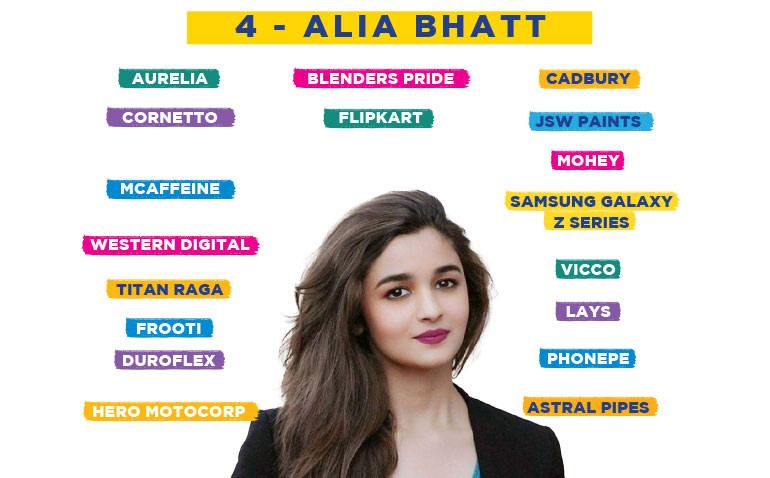

Aviral Jain, Managing Director (Valuation Advisory Services) at Kroll says that with a splendid performance at Tokyo Olympics and yet another successful IPL season, Indian sportspersons are also emerging as leading brand endorsers today. “Not only have the sportspersons witnessed a significant jump in the number of endorsement deals, they now also enjoy a massive social media fan following and engagement benefits due to lower competition from the movie stars with limited theatrical releases,” he says.
“The overall brand value of the top 20 celebrities in 2021 is estimated at USD 1.2 billion, an increase of about 12.9% from the previous year,” he adds.
Abhik Santara, Director and CEO at ^atom network says that 30-40% of the brands who work with them, have the requirement of celebrities. “Nowadays, a lot of advertised brands belong to the D2C category. Such brands need celebrities because they are mostly digital-first brands. The attention span of digital viewership is very different from that of the classical mediums. So, the requirement of a celebrity for a D2C brand is more than an established brand,” he says.
Santara believes that the recommendation of a celebrity for a brand is category-dependent. “We have to consider two to three important factors while proposing a celebrity. First, relevance of the celebrity. If we are talking to a particular consumer set, we have to see the relevance of the celebrity to the brand. It’s not just a pretty face, but something which carries the value of the brand seamlessly into the value of the celebrity. The second thing that we look for, especially when it is about targeting the millennials and Gen Z population, is the celebrities’ engagement and their popularity on social media. If the celebrity is popular on those platforms, then you can ride on that. Third, the stability of the celebrity. We have to see what field the celebrity is from and how volatile that field is. For example, things are really volatile in cricket. So, if you sign up a cricketer for two years and if he does not keep performing, his brand value will go down and that will not help your brand.”
This indicates that the performance of a celebrity could directly affect the performance of the brand that he or she endorses.
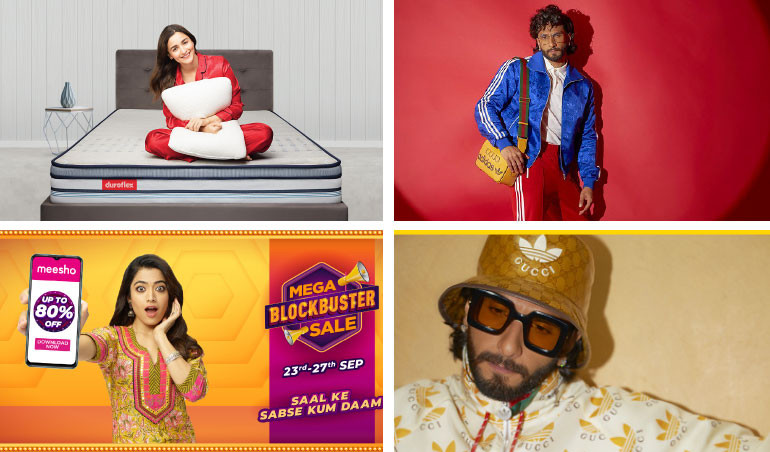
Harish Bijoor, Business & Brand-strategy Expert & Founder at Harish Bijoor Consults Inc. says that a celebrity must fit into the DNA of the brand and vice versa. This is the correct fit for any choice. “Our recommendations actually are brand-centric. The brand is more important than the celebrity. The brand is the lure and the celebrity is the bait. When the celebrity matches the brand and its ethos, the point of differentiation emerges,” he says.
According to the Kroll’s report, a celebrity may be engaged by a corporation or an advertiser in two key engagement models — a) a fixed fee and term engagement model, b) a one-time engagement model. In the first and the more popular model, a celebrity is contracted for a specified term (usually one or two years) for a fixed-fee payment that may be made through an initial signing amount with the balance to be paid upon completion of specified activities. The second and less popular form of engagement is a one-time appearance by a celebrity for a specified event. This may be in the form of a single photo/ video advertisement shoot or a single post on social media platform or even an event attendance.
As brands are always ready to rope in celebrities of their choice, the celebrities, specifically the A-listers, get the opportunity of endorsing dozens of brands at the same time.
Gurpreet Singh, Co-Founder & COO at One Digital Entertainment believes that too many endorsements by celebrities do not affect the objectives as long as they justify the final outputs. “There are celebrities who choose to endorse only select products and then there are celebrities who fit into wide range of brands across FMCG, automotive, fashion, e-commerce, etc. Each needs to have a distinct tone, clear message and true-to-narrative value for the consumer, to enjoy a high share of voice for that brand or product. Big or small, celebrities should be able to justify the endorsements on screen. The brand-to-celeb connect and the celeb-to-audience connect is very important here.”
Echoing the same sentiment, Nikhil Taneja, Co-Founder and CEO at Yuvaa says, “I think it comes down to the celebrity, and the way they go about promoting the brands. For example, Aamir Khan and Ranveer Singh always find a different character to play in their brand endorsements. We remember ‘Ranveer Ching’ or Aamir Khan’s Coke ads because they ensured they were memorable. That’s the way brands need to work with celebrities - collaborate with them for something new and different.”
At times celebrities endorsing multiple brands get into controversy for different reasons. Does that affect or help the brands that they endorse? Abhik Santara, Director and CEO at ^atom network says, “Celebrity image is very closely related to the brand image and hence, there is always a certain amount of risk if a celebrity gets bad press. For example, Salman Khan and Sanjay Dutt had their share of controversies in the past. They still enjoy a wide level of acceptance among the audience, but a lot of brands withdrew at that points of time because of their controversies. Likewise, when Shah Rukh Khan’s son got arrested, Byju’s suspended him for a while, but then got him back. Today brands also get trolled badly in media if they are seen associating with somebody who is getting a bad name as an endorser. So they try to play it safe.”
He says, “There is, however, a flip side to it. But I don’t think that brands do that intentionally because it’s a very risky a rope to walk on. If a brand has a big celebrity and if that celebrity gets into a problem, people start talking about the brand too. During such a time the brand gets much more social media mentions too. For example, Amitabh Bachchan’s controversy gave Kamla Pasand far better mileage than what just pure advertisement would have given them.”
There has been a lot speculations about the latest trend of roping in celebrities as share-holders of the brands. Nikhil Taneja, Co-Founder and CEO at Yuvaa says, “I feel it’s an even better model because it holds celebrities accountable to the products they are selling. If someone is selling a ‘sustainable’ product and has actually invested in it, people know that the celebrity genuinely believes in its impact. It’s a fantastic way of collaboration and also increases the value of the brands, when the celebrities put their money where their mouth is.”
Harish Bijoor, Business & Brand-strategy Expert & Founder, Harish Bijoor Consults Inc. says, “Celebrities are now looking to park their moneys in investments. These are good investments. 9 out of 10 will fail, but the one that wins, will make up for the others.”
While celebrities are still somewhat indispensable for brand endorsement, influencer marketing has also been growing strong in India.
Aashutosh Katre - Director, Yellow Seed says, “Both brands and agencies across the country continue to be very keen on collaborating with influencers for their campaigns. This has resulted in a phenomenal surge of up to 40% in the budget spent on influencers as observed by Zefmo in their India Influence Report 2021.”
“Micro-influencers have a strong audience base who often tend to trust them and eventually revere their content. This tight-knit community built by them is a strong reason for drawing a higher engagement rate. This impresses and attracts brands who use this opportunity to amplify their reach via these opinion generators. When it comes to macro-influencers, considering the time and effort they spend on establishing themselves in a niche category, they enjoy a favourable position as a way to generate chatter faster. So, brands that wish to reach the masses or seek virality in a moment often seek macro-influencers,” he says.
Gurpreet Singh, Co-Founder & COO at One Digital Entertainment says, “It’s true that owing to the intimate nature of social media, digital creators have carved their niche for themselves through a direct connect with their flock and now are the leading choice for most brands, but celebs also have their own space in the industry. It’s a mix bag situation now that has widened many pathways for the brands.”
Abhik Santara, Director and CEO at ^atom network however, says the role of the celebrities is absolutely different from that of the influencers. “Influencers are great in a different funnel. If you look at a sales and marketing funnel, the top funnel will be more about awareness and engagement and that’s where bigger celebrities do the job. Influencers help lower down the funnel - when the conversions are happening, when the conviction of buying or explanation of products are happening, or when offers are happening. For example, Katrina Kaif will come and say, ‘Hey, this is a great skincare product.’ But a micro-influencer will come and explain to you how to use it. They will convince you to purchase it, and will give you some offers. Katrina Kaif cannot do that because that will not be believable.”
The brands say that they choose their celebrities based on their analyses to meet their objectives.

Shankar Prasad, Founder and CEO, Plum says, “We consider two major aspects when it comes to selecting a celebrity for promoting products – personality fitment with the brand and objective of the endorsement. For example, we recently signed up Rashmika Mandanna and Mithila Palkar as brand ambassadors for Plum, and Ananya Panday for Plum BodyLovin’. Plum is a youthful brand that resonates with the confident woman of today. Hence, on-boarding these millennial stars was a natural fitment with the objective of strengthening the connection with our consumers and reaching out to millions of more women who will emotionally associate with our products.”
In June, Plum roped in Rashmika Mandanna as a brand ambassador cum share-holder because the actor was not ready to come to a plain brand endorsement deal. When asked if the idea of signing up a celebrity as a share-holder sustainable, he says, “A shareholder is someone who believes in the brand and hence invests in it. Roping in a celebrity helps build more credibility and relatability for the brand in the eyes of the audience. It is a great opportunity for both the celebrity and the brand to build on the combined equity, ultimately contributing to their respective brand image.”
Ajay Singh Parihar, Marketing Head, Healthcare OTC, Dabur India Ltd. says, “I think the rules are fairly simple. One has to do a brand-personality study and try to match it with the celebrity under consideration. For instance, a brand like Hajmola cuts across geographies, genders and age groups. Therefore, we have chosen Ajay Devgan for that brand because he is equally popular among the consumers across those segments. Also, the kind of films that he has done and the kind of personality he has, are very conducive for the brand, and hence we have chosen him. Regional celebrities are also equally important, and hence we have Abir Chatterjee for Hajmola for the audience of West Bengal. Likewise, we roped in Shruti Marathe for Lal Tail for Maharashtra. We also consider the risk associated with the celebrities while choosing them. Some celebrities are dependable for future, because they were not involved in any controversy in the past. So, that factor also plays an important role.”
Karthik Nagarajan, Chief Content Officer, Wavemaker India and Head – Branded Content, GroupM India says, “Identifying the right celebrity for a brand used to be an intuitive exercise. However, today we are able to do this in a data-led way. Thanks to the technological investments we have made in this space, we are able to take data-driven decisions when it comes to ensuring the right match in audiences (between the celebrity and the brand) or ensuring culture-fit or even in doing brand safety checks. There are more than 100 data variables that go into every decision we make on a brand advocate today – whether influencer or a celebrity.”
Prashant Awasthi, Marketing Leader, Siyaram Silk Mills Ltd. says that there should be a congruency between a brand and its brand ambassador. “They should look, think and act alike. The second thing which comes into play is the brand’s strategy. If my strategy is to lure the youth, the brand ambassador should be someone who is capable of doing that. For a brand like Siyaram’s, trust and quality are very important. Our brand ambassador is Ranveer Singh and he is experimental in true sense. But there are two things which are in match - trust and dependability. If Ranveer Singh is doing any film, audience will think it to be a quality movie, because he is a quality actor. As a brand, we want to connect to the younger audiences and that’s why we selected him as our brand ambassador.”
Saurabh Baishakhia, President, Appliances, Usha International says, “USHA is a household name across India and for us, celebrities play an important role in inspiring aspiration and building brand recall for our products. In the recent past, we have associated with multiple A-list stars in India, who have helped us reach out to our audiences and consumers across regions in the country. Most recently, we unveiled a co-branded TVC campaign with Shabaash Mithu, featuring actor Taapsee Pannu. The TV commercial was part of USHA’s partnership with the movie, which is a biopic based on world renowned former cricketer Mithali Raj, produced by Viacom18 Studios. Earlier this year, we had Mithali Raj as our brand ambassador across product categories.”
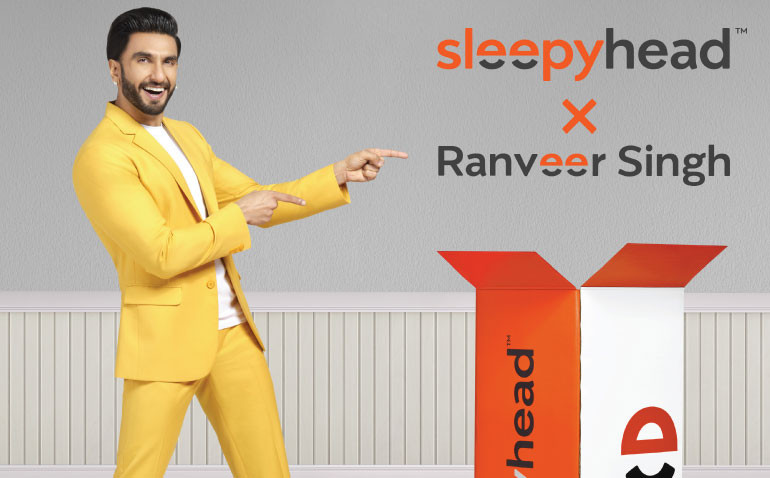
P. Madhavan, EVP - Sales & Marketing, TVS Eurogrip says, “Value compatibility is a very important factor while choosing a celebrity to endorse or promote a brand. Earlier this year we announced that TVS Eurogrip Tyres will be the principal sponsor of CSK for three years. This is a high impact partnership, as big as it gets within the IPL opportunities. TVS Eurogrip is all about high performance tyre technology that makes the rider the most confident one on the road and Chennai Super Kings similarly have been consistently delivering high performance. We saw great synergies between TVS Eurogrip & CSK and through this association both the brands have benefitted.”
While a huge number of brands are running after celebrities to get their products endorsed, there are brands who have managed to lead the markets without any celebrity. Crompton is one such brand which has not used any celebrity over the past 80 years.
Pragya Bijalwan, CMO at Crompton says, “Celebrities are definitely important, but you need to understand what works for your brand. As a brand, Crompton is trusted and salient. It’s the leader in certain categories and it’s going very fast in some other categories. So, we believe that currently it does not need a hook of celebrity face to be identified, or to create awareness. As far as the products are concerned, the task is to work on other side of the funnel - creating consideration for the brand. For that we work with micro-influencer with strong credentials.”
When asked, if they will consider roping in celebrities in future, she says, “Never say never. It depends on what a category needs at a particular time and what works well for us. The world is not static and hence Crompton will also not be static. Thus, it’s too early to say if we will take up celebrities in the future or not.”
How important are celebrities in India today?
The number of endorsements of the top 20 celebrities in India increased by more than 50% in 2021 from the previous year.
The overall brand value of the top 20 celebrities in 2021 is estimated at USD 1.2 billion, an increase of about 12.9% from the previous year.
Virat Kohli, Ranveer Singh, Akshay Kumar, Alia Bhatt and MS Dhoni were the top five celebrities in 2021. (Source: Kroll)
30-40% of brands have a requirement for celebrities to promote their products and services. (Source: ^atom network)




